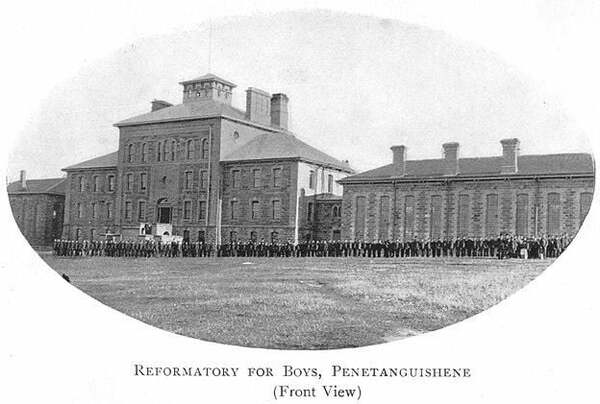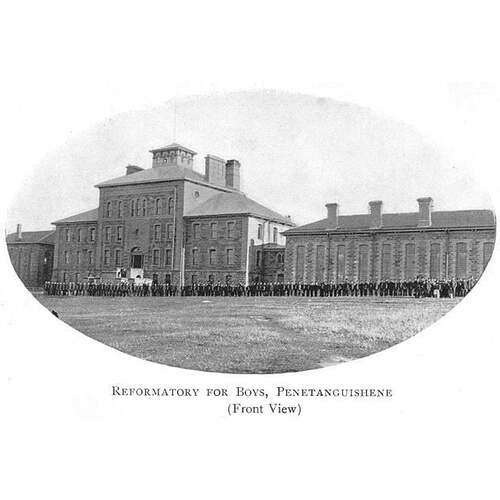
Source: Link
McCROSSON, THOMAS, businessman, editor, and reformatory superintendent; b. 27 Jan. 1827 in Strabane (Northern Ireland), son of Hugh McCrosson and Catherine McCallum; m. first November 1856 Deborah Elizabeth Parker (d. 1876); they had no children; m. secondly 25 Nov. 1879 Marie Lemoine in Penetanguishene, Ont., and they had three sons; d. there 2 April 1905.
For most of his life Thomas McCrosson was active in the affairs of the Roman Catholic Church. Much of the personal information about him derives from a lengthy obituary prepared by a friend, journalist William Halley, and published in the Catholic Register. Evidently McCrosson had immigrated to Lower Canada as a youth of 19 in 1846 and settled in Montreal, taking up the trade of hatter. Becoming knowledgeable in the fur trade, he travelled to Europe for his employers. In the early 1850s he moved to Toronto, where he set up his own hat and fur business opposite St James’ Cathedral.
Halley relates that McCrosson “entered with ardor into every movement for the benefit of his countrymen and co-religionists.” A fervent admirer of Thomas D’Arcy McGee*, he was a political associate of a number of prominent Catholic leaders, including Frank Smith; from 1877 to 1879 he was editor and publisher of the Toronto Tribune, a Catholic weekly that “sustained the principles of the [Ontario] Catholic League.” It seems likely that his appointment on 1 July 1879 by the Ontario Liberal government of Oliver Mowat to the superintendency of the Reformatory Prison at Penetanguishene was attributable to political motives, possibly to the administration’s desire to place Catholics in important government jobs.
McCrosson’s historical significance lies in his superintendence of the reformatory until it was closed in 1904. Once he had been appointed, Ontario prison inspector John Woodburn Langmuir* declared himself determined to carry out a “revolution of the present system” so that Penetanguishene would become “a Reformatory in fact,” instead of a prison for children. He sent McCrosson to study facilities in the United States in order to be able to eliminate from the Ontario reformatory “its more glaring defects” and “substitute therefore the best methods . . . which skilled specialists in well-managed institutions have adopted.” Langmuir’s instructions were specific. The terms convict and prisoner were eliminated in favour of boys, the warden became superintendent and the guards overseers, and the name of the institution was changed to the Ontario Reformatory for Boys. McCrosson was instructed to “use every means” to gain the confidence of the boys and to suspend any officer who displayed harshness. Everything possible was done to alter the appearance of the institution to make it seem less prison-like. As a demonstration of trust, the boys received a substantial degree of liberty, being able, for example, to attend church in town with minimal supervision. These efforts were capped by a statute in 1880 that made it possible for them to earn remission and allowed the superintendent to place some of them out on apprenticeship.
Almost immediately Langmuir and McCrosson learned that they had underestimated the challenge they faced. Many boys took advantage of the lax administration to escape. Others seemed to manifest increased hostility. Perhaps because of a reassertion of traditional discipline, conditions soon improved. After 1880 McCrosson ran the facility in a way which did not differ substantially from that of his predecessor, William Moore Kelly. Indeed, his administration was beset by similar problems, and his disillusionment was frankly expressed in his testimony in 1890 to the commission on the prison and reformatory system of Ontario, chaired by Langmuir. Asked whether Penetanguishene, as operated under the existing system, could ever be made an effective reformatory, McCrosson responded “no, never.” He argued that the dominion government’s restrictive control of the pardoning power, combined with the tendency of provincial judges to sentence boys to definite rather than indefinite terms, undermined any possibility of achieving a system of remission based on good conduct. He described the 1880 statute allowing indefinite sentences as “entirely inoperative” and admitted that there was no possibility of classifying the boys and that he did not even keep a regular record of their behaviour. The institution’s industrial system existed primarily “for maintaining order”; when the boys left they had “a very imperfect knowledge of any trade,” and the small amount of good land in the Penetanguishene area limited possibilities for farming. The reformatory’s location, he agreed, was a drawback because “we are here all the twelve months in the year without seeing anyone who takes an interest in the inmates.” As for the section of the statute that permitted boys to be released through apprenticeship, it was “almost entirely a dead letter” because McCrosson had “no means of knowing who will take apprentices” or of knowing what happened to the boys after release.
In its Report of 1891, the commission recommended numerous changes in the administration of the Penetanguishene facility, including its removal to a more suitable locality. Few of these reforms were carried out and, perhaps surprisingly, McCrosson remained as superintendent. By the mid 1890s, with the opening of four industrial schools in the Toronto area and the expanding prestige of John Joseph Kelso*’s Children’s Aid Society movement, which offered a creative alternative to incarceration, Penetanguishene was an institution in decline. McCrosson nevertheless achieved some successes. Between 1893 and 1902 he released 64 boys as apprentices and another 272 were pardoned; historian Andrew Jones has calculated that almost 60 per cent of those committed in this period were pardoned or apprenticed before finishing their terms. Despite these efforts, and facing criticism over rising costs, the reformatory was unable to compete with alternative forms of care for delinquent boys. It was closed in 1904.
As superintendent McCrosson had operated under severe constraints. Although he professed to believe that the institution played a useful role, he had been unable to persuade the province to open a reformed facility in a more suitable location. Lacking in the training which would soon be demanded of those who did comparable work, McCrosson none the less held progressive views about the causes of delinquency. He told the commission of 1890 that he doubted the significance of heredity in leading boys to crime because fully two-thirds of those he had come into contact with were the children “of honest, careful, thoughtful parents,” a position Langmuir described as “remarkable.” Even J. J. Kelso, though hostile to the reformatory, retained a warm regard for its superintendent. From time to time there had been charges that McCrosson’s appointment had been political. In the legislature in 1899 members of the Conservative opposition claimed that he was a mere figurehead who campaigned at elections while his assistant did all the work in the reformatory. Although this accusation was exaggerated, Kelso himself asserted that the appointments of staff were “entirely political”; during several visits he had not seen one employee, “outside of the Warden, who seemed at all fitted” for the work. McCrosson, he concluded, in the most revealing assessment of the superintendent’s career, was a “good-natured man who always had a kind word for the lads . . . but he had absolutely no control. He had not appointed any of those under him, he could not dismiss them, and he had found by experience that to find fault or criticize their work was not only useless but increased his burden and anxieties, so he made the best of the situation and said nothing.”
AO, RG 22, ser.315, no.5196; RG 80-5, no.1879-010097. NA, MG 30, C97; RG 31, C1, 1891, Penetanguishene. Catholic Register, 6 April 1905. Irish Canadian (Toronto), 3 Dec. 1879. Northern Advance (Barrie, Ont.), 13 April 1905. Canadian men and women of the time (Morgan; 1898). Andrew Jones, “‘Closing Penetanguishene reformatory’: an attempt to deinstitutionalize treatment of juvenile offenders in early twentieth century Ontario,” OH, 70 (1978): 227–44. Ont., Commission appointed to enquire into the prison and reformatory system of Ontario, Report (Toronto, 1891; also issued in Ont., Legislature, Sessional papers, 1891, no.18); Sessional papers, annual reports of the Penetanguishene reformatory in the reports of the inspector of prisons and public charities, 1867/68–1880/81, and of the inspector of prisons and reformatories, 1881/82–1903/4; Statutes, 1880, c.34. R. B. Splane, Social welfare in Ontario, 1791–1893; a study of public welfare administration (Toronto, 1965).
Cite This Article
Peter Oliver, “McCROSSON, THOMAS,” in Dictionary of Canadian Biography, vol. 13, University of Toronto/Université Laval, 2003–, accessed December 28, 2025, https://www.biographi.ca/en/bio/mccrosson_thomas_13E.html.
The citation above shows the format for footnotes and endnotes according to the Chicago manual of style (16th edition). Information to be used in other citation formats:
| Permalink: | https://www.biographi.ca/en/bio/mccrosson_thomas_13E.html |
| Author of Article: | Peter Oliver |
| Title of Article: | McCROSSON, THOMAS |
| Publication Name: | Dictionary of Canadian Biography, vol. 13 |
| Publisher: | University of Toronto/Université Laval |
| Year of publication: | 1994 |
| Year of revision: | 1994 |
| Access Date: | December 28, 2025 |



